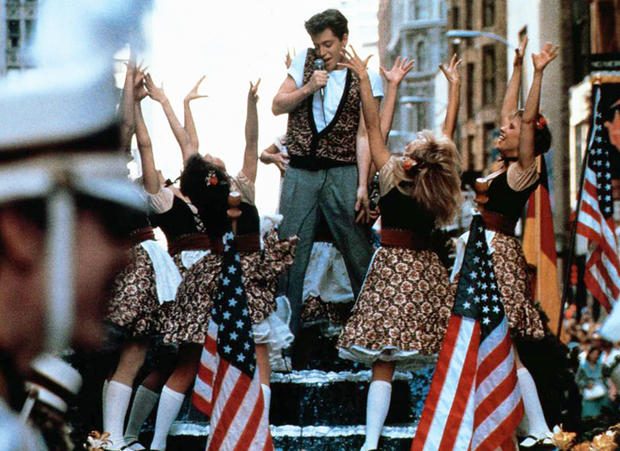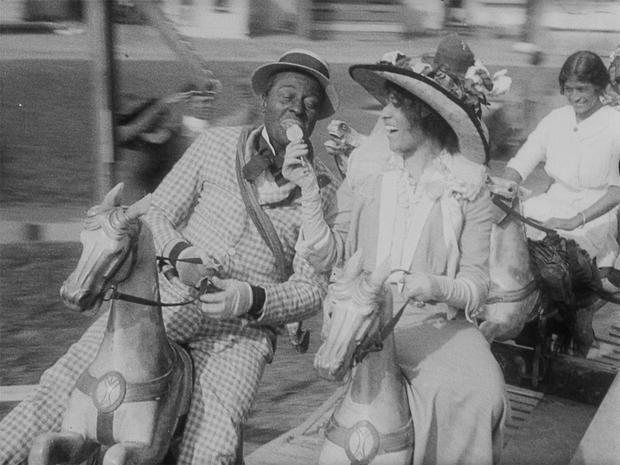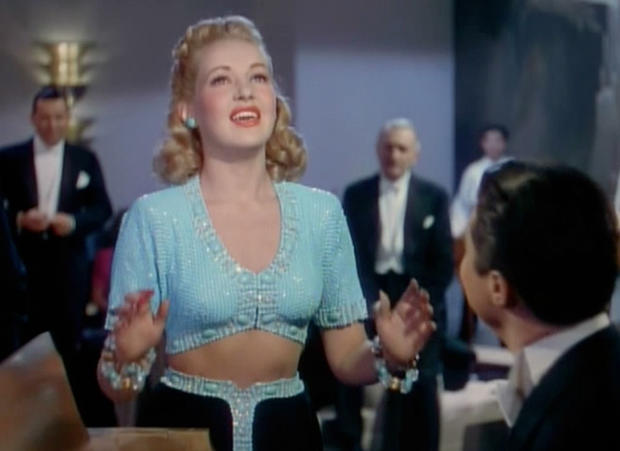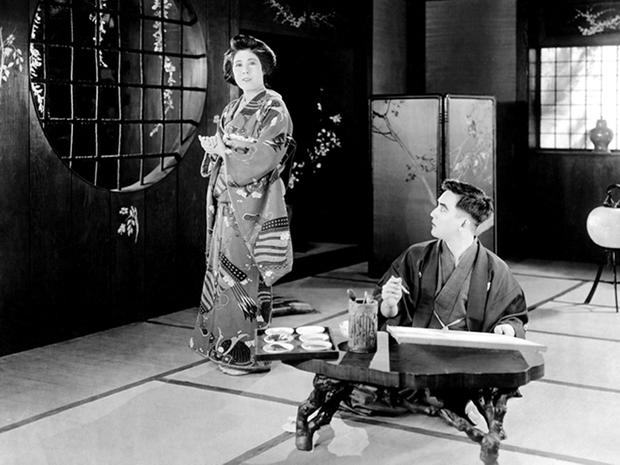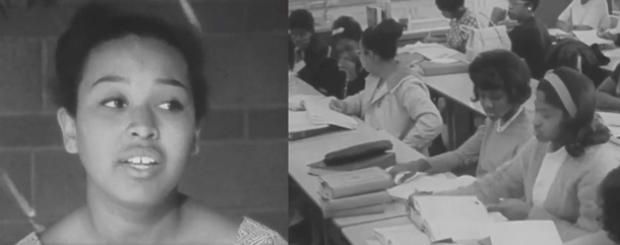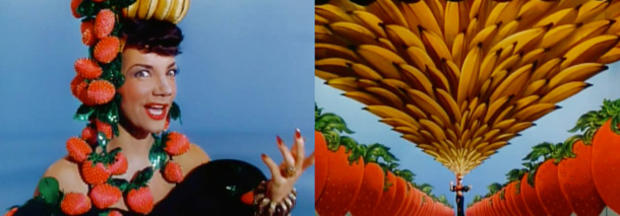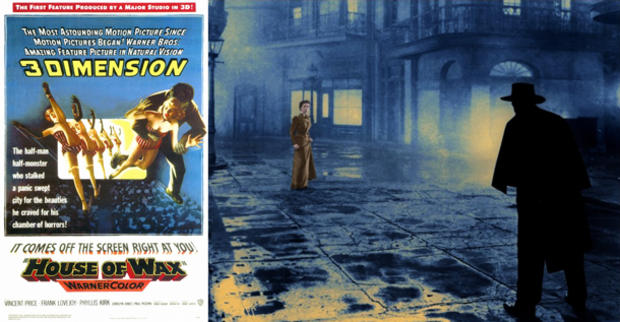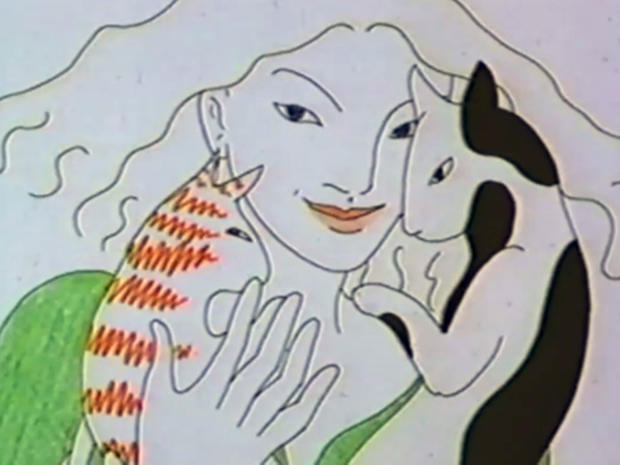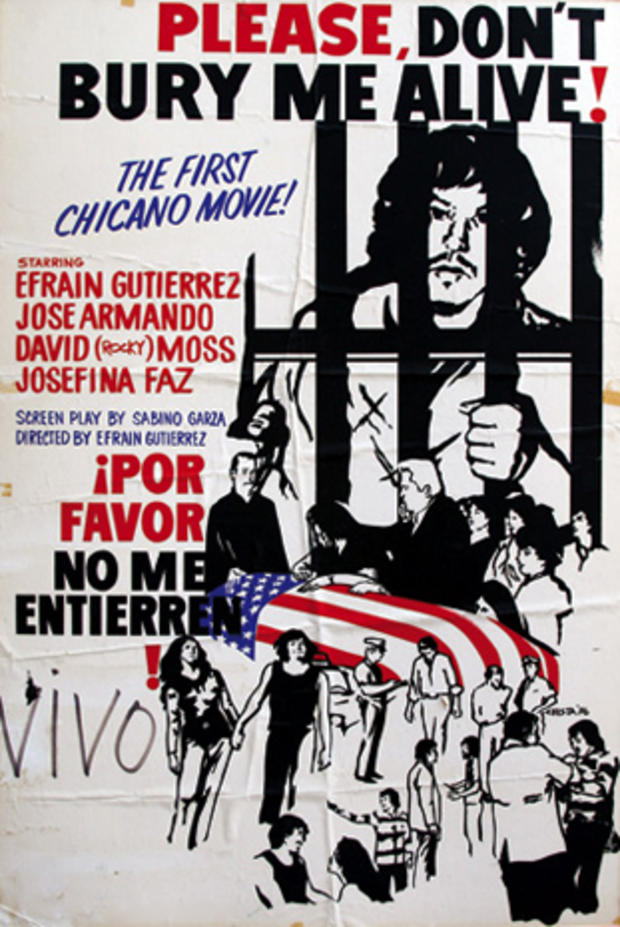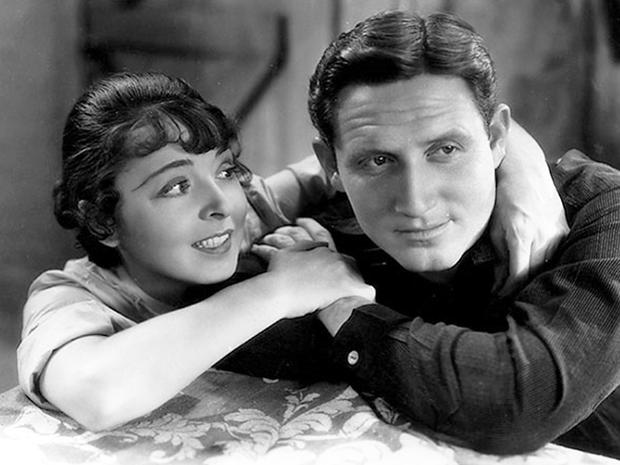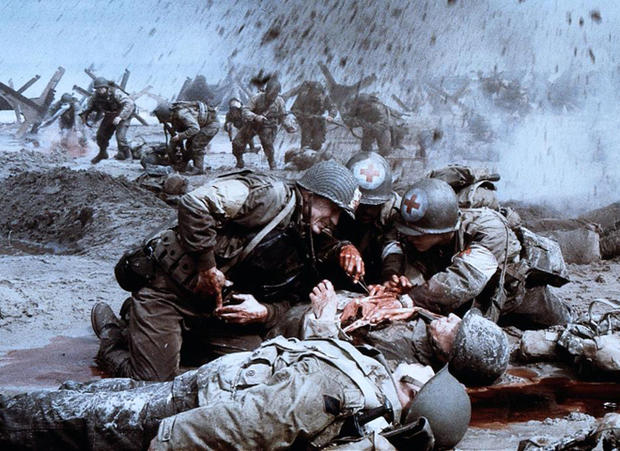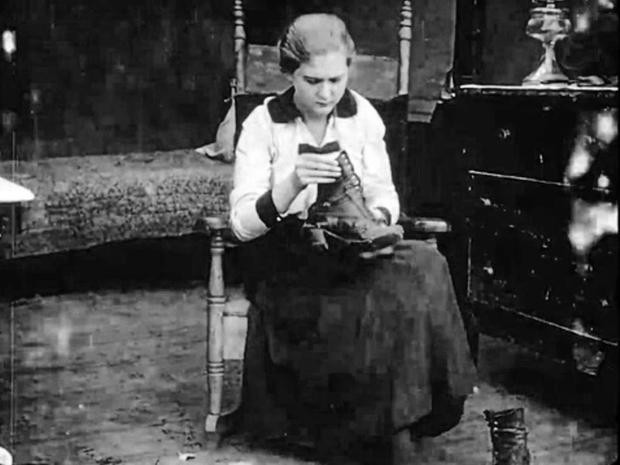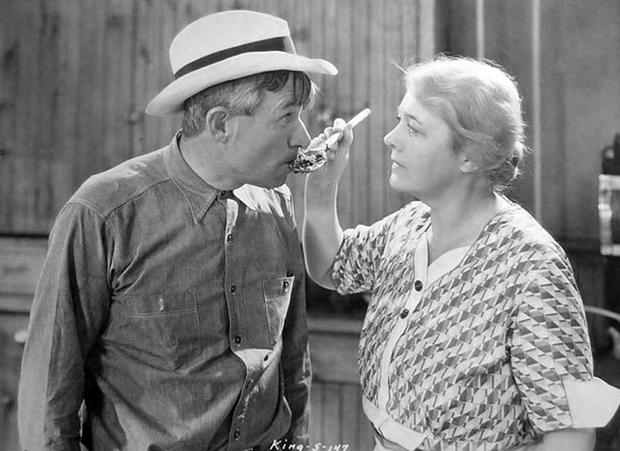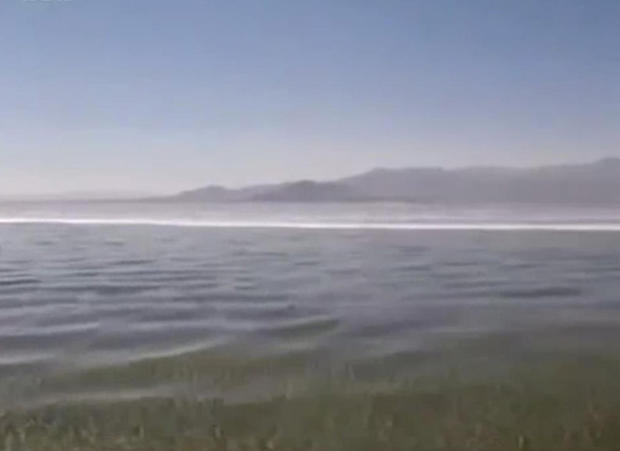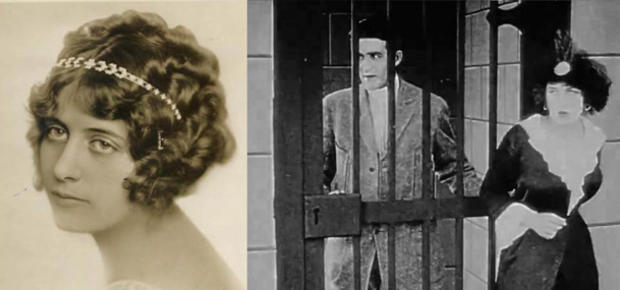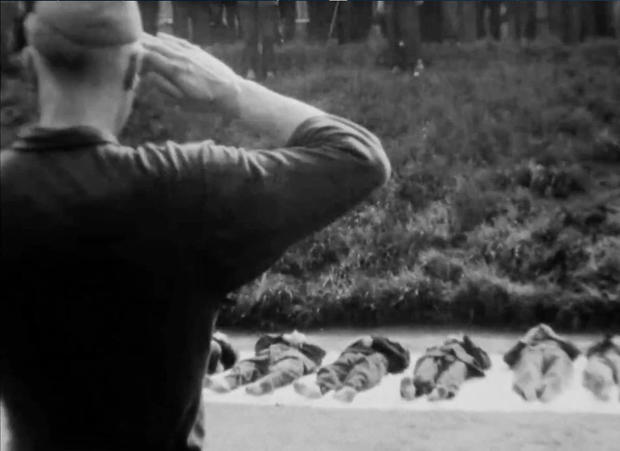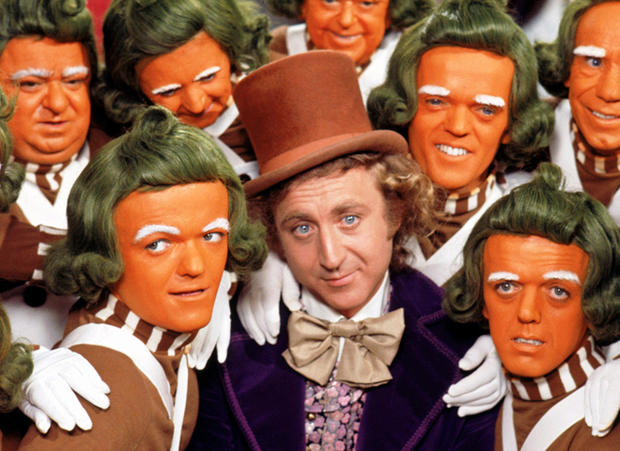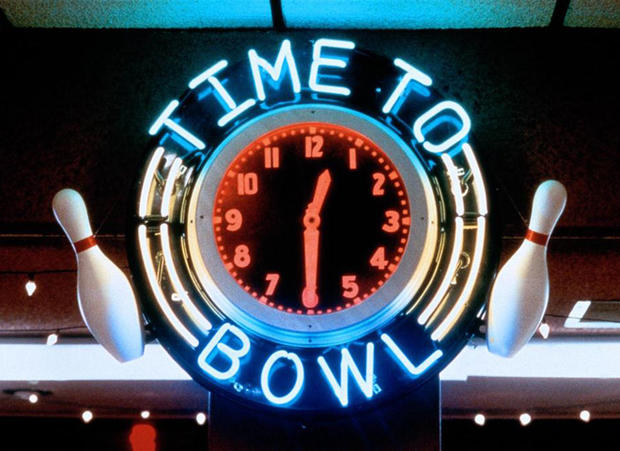2014 additions to National Film Registry
Playing hooky from school for the day, Ferris Bueller (Matthew Broderick) leads a joyful performance of "Twist and Shout" in the streets of Chicago in "Ferris Bueller's Day Off" – one of the latest additions to the Library of Congress' National Film Registry.
Each year the Library adds 25 titles to
the Registry, its compendium of films that have been judged to be culturally,
aesthetically or historically important and worthy of preservation.
The Registry covers not just Hollywood classics and fan favorites, but also
documentaries, experimental films, cartoons, educational and training films,
ads, music videos, and even home movies, in what is the most democratic and
American of film lists.
By CBSNews.com senior producer David Morgan
Restoration
Left: The Eye Film Institute of Amsterdam's digital restoration of Lois Weber's "Shoes" (1916). The only known nitrate print, located in the archives' underground bunker in the Netherlands, has suffered deterioration due to bacteria and mold.
About 70 percent of films from the early years of cinema are lost - damaged, deteriorated, destroyed by fire, or uncared for by the studios that created them. In addition to spotlighting cinematic achievements of the past, the National Film Registry also helps protect our film heritage, by mandating preservation copies of each Registry title be stored at the Library.
This year's additions bring the number of National Film Registry titles to 650 - a fraction of the films produced in America since the late 19th century, but vitally important.
Click through the gallery to see the latest Registry films:
"Bert Williams Lime Kiln Club Field Day" (1913)
Although black actors had appeared in movies as early as 1909, none of those films still exists. At left: Bert Williams and Odessa Warren Grey are seen in rushes shot in 1913 by Biograph Studios, in out-takes and raw footage recently identified by the Museum of Modern Art in New York City as the oldest surviving film featuring African-American actors.
Seven reels of untitled rushes were found among the 900 negatives that were acquired by the museum following the closure of Biograph. No script, intertitles or production credits for the "Bert Williams Lime Kiln Field Day Project" had survived.
By examining the footage frame-by-frame (including hiring a lip reader to determine the dialogue), MOMA's film curators reconstructed the planned film's narrative as a comedy concerning Williams' character (a member of a black social club), with elements of romance, dancing and larceny.
"The Big Lebowski" (1998)
This highly-quotable Coen Brothers comedy, a freewheeling riff on Raymond Chandler mysteries, stars Jeff Bridges (right) as The Dude, a stoner bowling aficionado who shares a name with a self-made millionaire caught in a kidnapping plot. But the machinations of dealing with extortionist Nihilists, with a hot-tempered bowling buddy (John Goodman) who is more hindrance than help - not to mention Julianne Moore's artist/aerialist looking for a sperm donor - are less important than the fact that Bridges' character exists. Filmdom would be so much poorer without The Dude.
"The Big Lebowksi" has won legions of fans, who attend conventions and bowling tournaments dressed as the characters. "Big Lebowski" weddings have even been held. Now their favorite bowler is preserved for history. The Dude, indeed, abides.
"Down Argentine Way" (1940)
Just as GIs overseas in World War II had Betty Grable to thank for a memorable pinup, Grable had 20th Century Fox star Alice Faye to thank for getting sick, knocking her out of this Technicolor musical confection and gifting her with a career-defining role. In addition to Grable heading to South America, where she finds romance with Don Ameche, the film featured the stylish Nicholas Brothers dance duo and singer Carmen Miranda in her U.S. film debut. Songs include: "Down Argentina Way" (nominated for a Best Original Song Oscar), "Mamãe Yo Quero," "Bambu Bambu," and "Sing to Your Señorita."
"The Dragon Painter" (1919)
Sessue Hayawaka (best known for his performance as the POW camp commander in "The Bridge on the River Kwai") formed his own production company, Haworth Pictures Corp., which produced this 1919 melodrama set in Japan, about a talented young artist (Hayawaka) who marries a beautiful woman (Hayakawa's wife, Tsuru Aoki) whom he believes is the reincarnation of a princess spirit. His happy union, however, stifles his artistic inspiration.
Filmed in Yosemite Valley, with a Japanese village recreated on location, "The Dragon Painter" has survived though a single print found in France. It was restored by George Eastman House and the American Film Institute, with new English intertitles translated from the French.
"Felicia" (1965)
UCLA film students Trevor Greenwood, Robert Dickson and Alan Gorg shot this 13-minute glimpse into the life of Felicia Bragg, a teenage African American-Hispanic girl living in the Watts neighborhood of Los Angeles. The time capsule qualities of the movie, and its craft, would be impressive enough, even if the impoverished neighborhood hadn't exploded soon after in rioting and racial tensions.
"You see all these men hanging round the corners all day long, doing nothing, playing checkers. They just don’t care anymore," Felicia says. "Perhaps it's too late for the adults, but it’s not too late for the young generation like myself."
"Ferris Bueller's Day Off" (1986)
"Bueller? … Bueller? …Bueller?"
John Hughes' sprightly comedy stars Matthew Broderick as a high school student playing hooky with his friends in Chicago, hitting more sites than any self-respecting tourist could see in a week. What starts out as a free-wheeling escape from parents and truancy-obsessed school administrators, however, becomes stressful for Bueller's pal Cameron (Alan Ruck), whose dad's prized Ferrari has been taken for a joyride. A box office hit, and one of Hughes' most critically-acclaimed films. Co-starring Mia Sara, Jeffrey Jones, Jennifer Grey, Edie McClurg, Charlie Sheen, and Ben Stein as a somewhat lost Economics teacher.
"The Gang's All Here" (1943)
Carmen Miranda, "The Lady in the Tutti Frutti Hat," is back (with a vengeance), in this 20th Century Fox Technicolor musical directed and choreographed by Busby Berkeley.
Plot? You want plot? Go somewhere else. This has songs, such as "Brazil," "You Discover You're in New York," "Soft Winds" (performed by Benny Goodman and his Orchestra), "A Journey to a Star," "No Love, No Nothin'," "I've Got a Gal in Kalamazoo," and "The Polka Dot Ballet."
But even more than the music is the eye-popping visual overload, such as the sight of Miranda wearing the largest fruit-bearing hat ever conceived. Audiences loved the excess, although The New York Times' film critic mused about the Freudian suggestions of all those bananas: "Mr. Berkeley has some sly notions under his busby."
"House of Wax" (1953)
A remake of the 1933 "Mystery of the Wax Museum," in which a killer encases his victims in wax and displays them out in the open, this was the first major studio 3-D film in color, and with stereophonic sound no less. And so what if the director, Andre de Toth, was blind in one eye and could not see in three-dimensions? The rest of us could enjoy the paddle-balls bounced into the audience, the leggy dancing girls, the spooky figures running through fog-shrouded streets, and marvelous Vincent Price, in the role that firmly encased him in the horror genre.
"Into the Arms of Strangers: Stories of the Kindertransport" (2000)
This Oscar-winning 2000 documentary tells the painful yet hopeful story of children who were shipped from their homes in central Europe in the late 1930s and early '40, to families in England living safely away from the ravages of war. The stresses of the children and their sense of abandonment by their parents - some of whom did not survive the Nazi regime - affected their entire lives, as did the generosity of the strangers who took them in. Directed by Mark Jonathan Harris, and produced by Deborah Oppenheimer, whose mother was one of the evacuated children.
"Little Big Man" (1970)
Already a star thanks to his breakout performance in "The Graduate" and the Oscar-winning "Midnight Cowboy," Dustin Hoffman took the even riskier role of 121-year-old Jack Crabb, who regales a visiting journalist with tales of his peripatetic life in the Old West - from being captured and raised by Native Americans, to his days as a merchant and apprentice to a huckster salesman, to a scout caught in a battle with General Custer. Makeup master Dick Smith created the aged Crabb, but it was Hoffman's crusty, wry narration that carried Arthur Penn's revisionist Western, adapted from the Thomas Berger novel. With Faye Dunaway, Richard Mulligan, Chief Dan George and Martin Balsam.
Luxo Jr. (1986)
In two-and-a-half-minutes, the promise of animation being able to evoke emotional responses from computer-generated characters was proved in "Luxo Jr.," which stars two balance-arm desk lamps (one parental, one child-like), engaging in some slapstick.
The ball-squashing character became an icon for Pixar, producer of such affecting animated features as "Up," "Finding Nemo," "Wall-E," "Ratatouille," and the "Toy Story" series. Directed by John Lasseter, this was the first three-dimensional computer-generated animated short nominated for an Academy Award.
"Moon Breath Beat" (1980)
This animated short was created by Lisze Bechtold while she was a student at the California Institute of the Arts' Experimental Animation program. The whimsical line-drawn animation follows a woman and her two cats engaging the world and the forces of nature.
Bechtold (who also contributed animation effects for "Star Trek: The Motion Picture") went on to a career as a principal effects animator ("Fern Gully: The Last Rainforest"), children's book author and illustrator.
"Please Don't Bury Me Alive!" (1976)
Historians refer to director-star Efrain Gutierrez's 1976 drama as the first Chicano feature. Independently produced, this tale of the San Antonio barrio in the waning days of the Vietnam War was booked into theatres across the Southwest, where it found an audience underserved by major Hollywood studios and hungry to see themselves on screen.
Shot in 16mm and starring Gutierrez himself (he said he couldn't afford real actors), the film features working-class Mexican-Americans dealing with such issues as love, racism, poverty and the war.
Guiterrez subsequently made two more features: "Chicano Love is Forever (Amor Chicano es Para Siempre)," and "Run, Tecato, Run," made after being incarcerated on what he called trumped-up charges aimed at dispelling his political activism.
Guiterrez disappeared from filmmaking for more than two decades, but a revived interest in his work led to his features being restored by the UCLA Chicano Studies Research Center
"The Power and the Glory" (1933)
Spencer Tracy stars in this tragic tale of a man's rise from poverty to riches to suicide, told in flashback - a style which some critics say influenced Orson Welles' "Citizen Kane."
Unrelated to the 1940 Graham Greene novel of the same name, "The Power and the Glory" co-starred Colleen Moore and Ralph Morgan, and marked the first screenplay by Preston Sturges, later renowned for writing and directing some of Hollywood's most enduring comedies (including "Sullivan's Travels" and "The Miracle of Morgan Creek").
"Rio Bravo" (1959)
With a nod to "High Noon," director Howard Hawks ticks down the clock on a showdown between a small town sheriff (John Wayne) and the well-armed gang of the dastardly rancher whose brother he holds prisoner. With the aid of a drunk (Dean Martin), a gunslinger (Ricky Nelson), and his old-coot deputy (Walter Brennan), Wayne stands toe-to-toe against John Russell's men - while off to the side stands Angie Dickinson.
One of Hawks' best, "Rio Bravo" inspired two similar Westerns by the same director ("El Dorado," with Robert Mitchum; and "Rio Lobo," also with Wayne), as well as John Carpenter's thriller of an attack on a police station, "Assault on Precinct 13" (1976).
"Rosemary's Baby" (1968)
Novelist Ira Levin found the perfect cinematic pairing with director Roman Polanski (helming his first American film) for this psychological thriller about a young, naïve mother-to-be (Mia Farrow) who becomes choked with fear that her neighbors are occultists threatening the life of her infant - and that her husband (played by John Cassavetes) is conspiring with them.
Co-starring Oscar-winner Ruth Gordon, Maurice Evans, Ralph Bellamy, Charles Grodin, Elisha Cook, and the voice of Tony Curtis, it was certainly the classiest horror film ever produced by exploitation master William Castle.
"Ruggles of Red Gap" (1935)
Charles Laughton stars as an English butler lost by his employer Earl in a poker game to an American nouveau riche living in a Washington State boom town. What's life like for a manservant in the Old West? Surprisingly invigorating, as Ruggles finds the American frontier to his liking - and the spirit of the Gettysburg Address (which the actor recites) an inspiration. Directed by Leo McCarey.
"Saving Private Ryan" (1998)
Steven Spielberg won his second Best Director Oscar for this World War II drama, which recreates the devastatingly bloody D-Day invasion on Omaha Beach. Filmed by cinematographer Janusz Kaminski and edited by Michael Kahn (who both also won Academy Awards), "Saving Private Ryan" follows squad leader Tom Hanks and his men (including Edward Burns, Tom Sizemore, Vin Diesel and Giovanni Ribisi) who live through the invasion of France only to be ordered to find and rescue a paratrooper (Matt Damon), the last survivor of four brothers-servicemen.
As a testament to the Greatest Generation, "Saving Private Ryan" proved to be an especially emotional tribute - too realistic for some veterans, as counselors reported some former soldiers suffering from bouts of PTSD due to the movie's brutal opening scenes.
"Shoes" (1916)
Lois Weber, a former evangelist, was one of the first female film directors, who used the medium with the zeal of a missionary. [She spoke of moving images as a "voiceless language."] Weber directed, wrote and/or starred in more than 100 films between 1911 and 1934, telling stories that tackled such issues as abortion, contraception, religion, child labor, prostitution and the death penalty. [Weber's "Where Are My Children?" was inducted to the Registry in 1993.]
In "Shoes," a young woman (Mary MacLaren) who is barely supporting her extended family with the wages of her store clerk job can hardly afford a decent pair of shoes. Her difficult situation leaves her prey to a wily scoundrel.
"State Fair" (1933)
Will Rogers and Louise Dresser star as Iowa farmers whose daughter finds love and more at the "State Fair." Janet Gaynor and Lew Ayres co-starred in this first movie version of Phil Strong's novel. [It was later filmed in 1945, starring Jeanne Crain and Dana Andrews, and 1962, starring Ann-Margret and Pat Boone.]
"13 Lakes" (2004)
The most recent film to be inducted on the National Film Registry (the law states a film must be 10 years old before being considered), "13 Lakes" is James Benning's feature-length meditation on the views of lakes of the American West. Shot on 16mm in static 10-minute takes, the film offers varying views of climate, topography and season, as light plays on water, and audiences fall mesmerized.
"Unmasked" (1917)
Grace Cunard was renowned as the "Queen of the Serials," appearing in more than 160 films, many at the fledgling Universal Studios, where she teamed with director Francis Ford on such hits as "The Adventures of Peg o' the Ring" and "The Broken Coin" (a lost film). In addition, Cunard wrote about 100 films, and she also directed or produced more than a dozen.
In "Unmasked," which she co-directed with Ford, Cunard plays a young jewel thief in a tug-of-war over a priceless necklace with another thief (also played by Ford).
"V-E + 1" (1945)
Samuel Fuller would go on to a career as the uncompromising director of such films as "Shock Corridor," "The Naked Kiss," "Pickup on South Street" and "The Big Red One" (inspired by his Army days in World War II).
But on May 9, 1945, Fuller was serving in the 1st U.S. Infantry Division when, armed with a 16mm Bell & Howell camera, he documented the aftermath of the liberation of a Nazi concentration camp in Falkenau, Czechoslovakia.
According to Fuller, he was asked to record the gruesome spectacle of the emaciated bodies of the near-dead, as well as burial preparations of the victims, by his battalion commander, Captain Kimble R. Richmond. The death-camp survivors, Fuller wrote, "raised their bald heads and looked at us, eyes sunken in anguish, their mouths agape, a hand here and there reaching out, grasping for anything, begging us for assistance in helpless silence."
In addition, the townspeople of Falkenau - who professed ignorance of the camp's true nature - were compelled by Richmond to witness the proceedings or face execution. They, like the viewers of Fuller's footage, could not turn away.
"The Way of Peace" (1947)
Between Frank Tashlin's output as a cartoonist and animator (he worked at Warner Brothers and Columbia in the 1930s and '40s) and as a director of broad Hollywood comedies starring the likes of Jerry Lewis and Jayne Mansfield (his credits include "The Girl Can't Help It" and "Will Success Spoil Rock Hunter?"), he also created a stop-motion puppet film that served as a plea for global peace in the atomic age.
Sponsored by the American Lutheran Church and narrated by Lew Ayres (star of the anti-war classic "All Quiet on the Western Front"), "The Way of Peace" mixed religious iconography with images of fascism and lynchings to tell Bible stories that evoked Christian values of love and tolerance.
"Willy Wonka and the Chocolate Factory" (1971)
Roald Dahl's novel, "Charlie and the Chocolate Factory," was adapted by the author for this glossy-color musical with the emphasis on the weirdly obssessive owner of a magical candy factory, who invites the lucky winners of some Golden Tickets for a rare tour. And what's inside the walls of Wonka's factory, apart from hordes of diminutive Oompa Loompas?
"Come with me and you'll be
In a world of pure imagination
Take a look and you'll see
Into your imagination."
And what we see, courtesy of Charlie Bucket (Peter Ostrum) and his grandfather (Jack Albertson), is a group of some of the foulest, meanest, most obnoxious kids you could never wish to be stuck on a group tour with. Even though they have wonderfully evocative names (Veruca Salt's moniker was later taken by an alternative rock band in Chicago), they cannot avoid revealing their inner selves.
Songs by Leslie Bricusse and Anthony Newley.
"The Big Lebowski"
For more info:
National Film Registry (Library of Congress)
National Film Preservation Foundation
By CBSNews.com senior producer David Morgan
